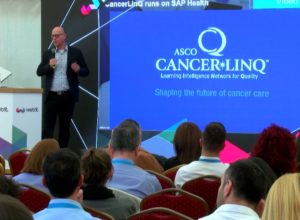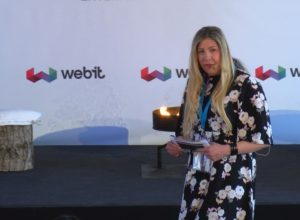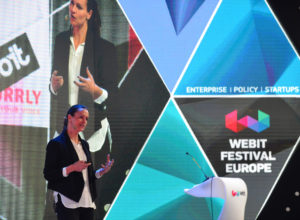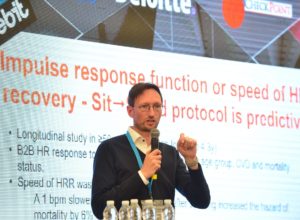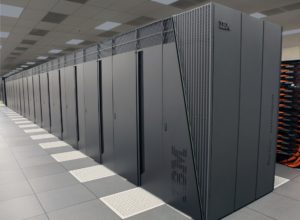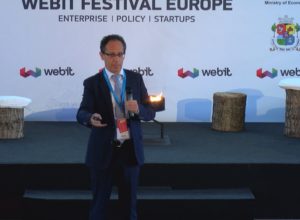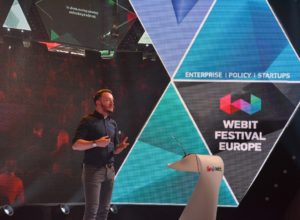Tag: Webit
Cyber criminals – living like celebrities!? Their money is not from...
Raj Samani is the Chief Scientist of McAfee. He is an active member of the Information Security industry, through involvement with numerous initiatives to improve the awareness and application of security in business and society. He was inducted into the Infosecurity Europe Hall of Fame in 2012.
At Webit.Festival Europe’17 he was talking about cyber criminals, who are having a pretty good life, living like celebrities, but their money is not from hard work, this is stolen money! He wants us to know what are we up against - a brutal individuals, who have more money than we do and they are investing and growing every minute. Some of the targets of cyber criminals are hospitals - for example, in the UK they attacked a hospital via email and the result was that every emergency patient was no longer treated! These crimes don’t affect random individuals, they affect the whole world. The most disturbing thing is that ransomware could be done by
11-year-old children. It is simple like that! Nowadays children have online access to guns, drugs and could run campaigns, which is very worrisome on so many levels.
Today with ransomware you have 3 ways - neutral data, paid criminals and now you can have your data back. Raj said that until July they have provided 10,000 successful decryptions free of charge - that’s 4 million US dollars, who haven’t gone to the criminals and people got their data back.
You can watch his presentation
[youtube https://www.youtube.com/watch?v=Ts1FttnxQEI]
Webit.Festival Europe 2018 will gather again top speakers, policy makers and enterprise leaders
Visit our website and book our Super Earlybird tickets.
Feel the Webit vibe with some of the best photos from this year’s event!
[easingslider id="4954"]
Healthcare at its Gutenberg moment
“The main and huge problem in healthcare is data. Big data and big amounts of it. You can’t start creating huge clinical data warehouses anymore. The amount of data is simply exploding.”In case you’re wondering who Gutenberg is, he is the guy who invented the printing press and thus changed everything back in the times by starting the Printing Revolution. Now healthcare is at the doorstep of a suchlike event. Dr. Clemens Suter-Crazzolara, VP of Product Management for Health & Precision Medicine at SAP gave a keynote at Webit.Festival in Sofia about what are people and companies already doing with the help of technology in order to improve patients’ and doctors’ health experience and the treatment of patients. The main and huge problem in healthcare is data. Big data, and big amounts of it. If we walk in any given hospital, we inevitably notice that lots of the data we provide or data already collected, is taken on notes, sheets or some format of paper. Other industries are moving to digitalization with rocket speed but in healthcare it is not happening and this process is still somehow a struggle. Privacy, security and access to the correct data are all difficulties underlying ahead of healthcare in its process of adapting to digitalization. You can’t start creating huge clinical data warehouses anymore. The amount of data is simply exploding. You have to think of intelligent ways that the data stays in different locations, but for instance, you can send federated queries to those locations and then collect the needed answers. The use of mobile devices increases with each passing day. There are many apps which people use for consulting on their physical health, consulting with a physician online or simply googling their symptoms but the patient engagement is not fully tailored to both the patient and the physician. The need of a common platform that collects the experience and practices from physicians all around the world, as well as helping to collaborate and get information from one another and facilitating their day to day work is at the roots of change in the health system and that’s the thing SAP is trying to create. You can watch the keynote of Dr. Clemens Suter-Crazzolara here. https://www.youtube.com/watch?v=AwyLgKvCaBQ Physical and mental health, personal care and wellbeing are an ever growing theme in today’s everyday life. Recognizing it as an integrant area of value and interest, the Health & Wellbeing Summit at Webit.Festival Sofia 2018 will gather again top speakers from the industry, unveiling top tendencies and knowledge from their practice. Have a glance at last year’s Webit with some of our best photos and check our different ticket options here. [easingslider id="4954"]
We deserve to fight for freedom in Internet
Internet freedom differs from country to country which together with the constantly changing online landscape makes it quite hard to say whether Internet freedom is an existing phenomenon at the moment. People are social beings, we talk to each other, exchange information and emotion and this is what makes us human. The fast and easy access to information and the social interaction online has opened a door for Internet in our lives.
At Webit.Festival Europe the Chief Digital Officer of AnchorFree Inc. Baglan Rhymes talked about the importance of Internet freedom. AnchorFree focuses on this topic because it aims to provide secure and anonymous access to information on the Internet to every single person on the planet. In reality, we take the online information and bring it into our physical world. This has an impact on who we are, our preferences, philosophies and the society we live in.
In the world of today, the Internet is becoming less free. Many governments use it to take down content they don’t approve of or to launch cyber attacks against their critics or other governments. Censorship has taken control over free speech. It is important to understand the difference between the methods of suppression and those of censorship. Suppression of free speech doesn’t have to take sophisticated forms of technology. Most often it has a political or a legal aspect and it requires vigilance which governments and the police have.
[caption id="attachment_5183" align="aligncenter" width="640"]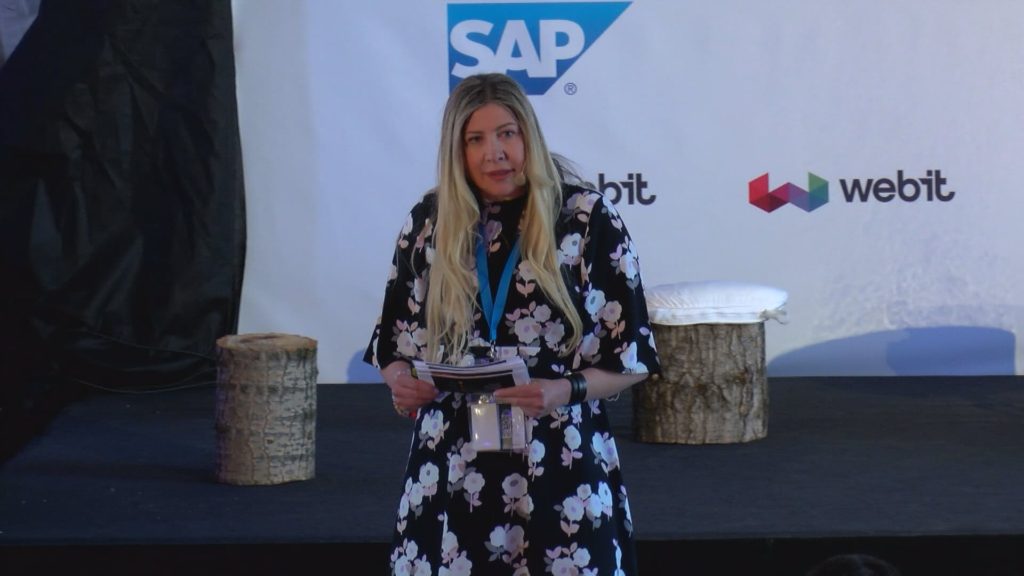 The Chief Digital Officer of AnchorFree Inc. Baglan Rhymes[/caption]
Censorship, on the other hand, takes a lot of technological forms. Such a complex and constantly evolving system as the Internet can be adapted for propaganda and manipulation. Social media in many countries is a very politicized and polarized tool which if used correctly can send a convincing but also a leading message. The media diversity shrinks and this results in many people turning into alternative sources of information. According to Baglan Rhymes:
The Chief Digital Officer of AnchorFree Inc. Baglan Rhymes[/caption]
Censorship, on the other hand, takes a lot of technological forms. Such a complex and constantly evolving system as the Internet can be adapted for propaganda and manipulation. Social media in many countries is a very politicized and polarized tool which if used correctly can send a convincing but also a leading message. The media diversity shrinks and this results in many people turning into alternative sources of information. According to Baglan Rhymes:
 The Chief Digital Officer of AnchorFree Inc. Baglan Rhymes[/caption]
Censorship, on the other hand, takes a lot of technological forms. Such a complex and constantly evolving system as the Internet can be adapted for propaganda and manipulation. Social media in many countries is a very politicized and polarized tool which if used correctly can send a convincing but also a leading message. The media diversity shrinks and this results in many people turning into alternative sources of information. According to Baglan Rhymes:
The Chief Digital Officer of AnchorFree Inc. Baglan Rhymes[/caption]
Censorship, on the other hand, takes a lot of technological forms. Such a complex and constantly evolving system as the Internet can be adapted for propaganda and manipulation. Social media in many countries is a very politicized and polarized tool which if used correctly can send a convincing but also a leading message. The media diversity shrinks and this results in many people turning into alternative sources of information. According to Baglan Rhymes:
“Social media has been spectacular in busting censorship and creating a challenge in the social sphere.”In the United States this role of social media has an impact on economy and trade. The country is most successful when the packaging and the messaging of the goods sold overseas, not the government propaganda or the military force, export the values of freedom and creativity. In reality, some of America’s best products exported abroad are in the form of downloading an application, accessing a website, streaming a movie or listening to music. People don’t have access to the culture and the values of America if their freedom on the Internet is restricted. Important companies as Apple, Alphabet, Microsoft, Amazon and Facebook export many of their products via the Internet and this is the only way they can reach consumers. Therefore, Internet freedom should be a priority for the US policy. Research shows that now there are 2.5 billion smartphones and 5 billion feature phones. It is expected that in a couple of years these feature phones will come online. The digital weapons in our hands in the face of social media, blogs and Wiki will make the way people access information and consume it a matter of life and death. The Internet is powerful enough to influence a change in any government regardless of it being democratic or not. It is our responsibility to respect that power and not to take the Internet freedom for granted. As Baglan Rhymes said:
“Make no mistake - if we lose the fight in Internet freedom we have lost the battle in maintaining our humanity and promoting democracy in the world.”You can watch her full lecture here: If you want to keep up with the latest trends in the world of digital economy and technology, then Webit.Festival is the right place for you. Visit our website and book 2 in 1 of our Super Earlybird tickets for Webit.Festival Europe 2018. Feel the Webit vibe with some of the best photos from this year’s event! [easingslider id="4954"]
Technology and its positive role in education now and in the...
Nowadays, technology is everywhere and it has a pretty extraordinary impact on our life. According to research, the average person checks their phone approximately two million times a year. Teens spend around nine hours a day consuming media. The numbers show technology is a necessity but what we get out of it depends on how we decide to use it and for what purpose.
During the 2017 edition of Webit.Festival Europe the CEO of Wurrly Nadine Levitt talked about the role of technology in education and the positive impact it can have on the current education system. Children should be able to learn skills at school which they can use later on in their life. And this is exactly what the education platform WURRLYedu stands for.
It is true that technology comes with its risks. Constantly checking our smartphones and the likes on the latest post on social media turns into a powerful addiction which fosters an unhealthy externally focused sense of value. Unfortunately, due to the anonymity it provides, technology could be used as a weapon by bullies who are much stronger when hiding behind a screen. Text messages, emails, social media - they all nurture shallow relationships by lacking an emotional contact which is the essence of face-to-face communication.
[caption id="attachment_5179" align="aligncenter" width="640"]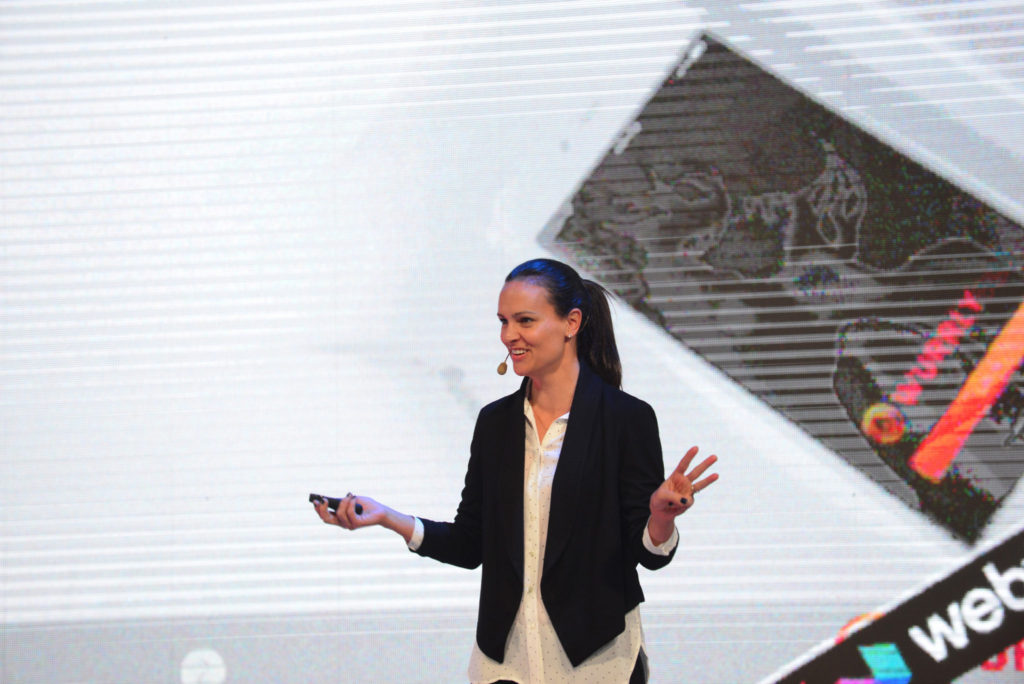 The CEO of Wurrly Nadine Levitt[/caption]
According to Nadine Levitt, the benefits of technology do outweigh the risks. The free access to vast amount of information empowers people and gives them the responsibility to be aware of what is happening around them. Mapping and forecasting save both time and money and make everyday life easier. Thanks to technology we can connect with friends and family around the globe and develop a stronger relationship with them. Through Augmented and Virtual Reality we experience places and worlds far from our current location. VR is very powerful - it can give sick children a chance to leave the hospital room and explore, play and have fun.
During her lecture, Nadine Levitt emphasized the importance of the skills she as a parent wants her children to learn at school. Education and technology should provide kids with opportunities to develop communication, collaboration, analytical and problem-solving skills.
The CEO of Wurrly Nadine Levitt[/caption]
According to Nadine Levitt, the benefits of technology do outweigh the risks. The free access to vast amount of information empowers people and gives them the responsibility to be aware of what is happening around them. Mapping and forecasting save both time and money and make everyday life easier. Thanks to technology we can connect with friends and family around the globe and develop a stronger relationship with them. Through Augmented and Virtual Reality we experience places and worlds far from our current location. VR is very powerful - it can give sick children a chance to leave the hospital room and explore, play and have fun.
During her lecture, Nadine Levitt emphasized the importance of the skills she as a parent wants her children to learn at school. Education and technology should provide kids with opportunities to develop communication, collaboration, analytical and problem-solving skills.
 The CEO of Wurrly Nadine Levitt[/caption]
According to Nadine Levitt, the benefits of technology do outweigh the risks. The free access to vast amount of information empowers people and gives them the responsibility to be aware of what is happening around them. Mapping and forecasting save both time and money and make everyday life easier. Thanks to technology we can connect with friends and family around the globe and develop a stronger relationship with them. Through Augmented and Virtual Reality we experience places and worlds far from our current location. VR is very powerful - it can give sick children a chance to leave the hospital room and explore, play and have fun.
During her lecture, Nadine Levitt emphasized the importance of the skills she as a parent wants her children to learn at school. Education and technology should provide kids with opportunities to develop communication, collaboration, analytical and problem-solving skills.
The CEO of Wurrly Nadine Levitt[/caption]
According to Nadine Levitt, the benefits of technology do outweigh the risks. The free access to vast amount of information empowers people and gives them the responsibility to be aware of what is happening around them. Mapping and forecasting save both time and money and make everyday life easier. Thanks to technology we can connect with friends and family around the globe and develop a stronger relationship with them. Through Augmented and Virtual Reality we experience places and worlds far from our current location. VR is very powerful - it can give sick children a chance to leave the hospital room and explore, play and have fun.
During her lecture, Nadine Levitt emphasized the importance of the skills she as a parent wants her children to learn at school. Education and technology should provide kids with opportunities to develop communication, collaboration, analytical and problem-solving skills.
“I want my children to be best equipped to be entrepreneurs, to be freethinkers.”, Levitt said.She believes the best way to learn is through experience followed by a reflection on that experience. Only when emotion is added to the experiential learning, it enters the long-term memory. Following this formula, WURRLYedu couples experiential learning with music which carries so many different emotions. Music is one of the few subjects left at school which are truly collaborative. It fosters empathy, engages students and develops creative thinking, analytical, problem-solving, management and collaborative skills. The combination between music and technology in education can work if the technology is easy to use and there is a compelling content which children find relevant. WURRLYedu engages students with meaningful content. The comprehensive song library gives them freedom to choose among different styles of music. The platform enables children to change a song, to play with it and customize it to their own taste. Kids have the opportunity to develop collaborative skills while songwriting or performing together. Tips from Grammy awards winning artists are integrated in the lesson plans to make them more relevant to children. As far as teachers are concerned, the platform enables them to create a music curriculum which engages students and fosters communication. Teachers can organize a classroom, send and grade papers and keep a history for each of the students. You can watch her full lecture here: If you want to keep up with the latest trends in the world of digital economy and technology, then Webit.Festival is the right place for you. Visit our website and book 2 in 1 of our Super Earlybird tickets for Webit.Festival Europe 2018. Feel the Webit vibe with some of the best photos from this year’s event! [easingslider id="4954"]
Welcome the new generation of integrated hybrid medical devices
One of the questions we ask and answer everyday is “How are you?”. For as simple question as that one, it is very difficult to respond objectively mainly due to the small amount of information we have about our physiological condition. And if we think this is the doctor's job, we better think again because it is estimated that 99.8% of our lives are spent outside our physician’s office or the hospital. Therefore, we are the only ones capable of answering that question and the medical devices of today are here to help us do it as accurately as possible.
At the 2017 edition of Webit.Festival Europe the Founder & CEO of Biovotion Dr. Andreas Caduff revealed the power of the new generation of integrated hybrid medical devices. If the goal is patients to use medical technology on their own, then it is the responsibility of the companies developing this technology to make it accessible to people and easy to use.
It is important to understand that digital health consists of more elements than just the software and the hardware. It is not enough to create the product only, simply because in order to integrate that product, a platform is necessary. Even though some stakeholders believe developing an app with the device will lead to success, in reality, there are more additional layers to be considered among which regulation is of great importance.
[caption id="attachment_5168" align="aligncenter" width="640"]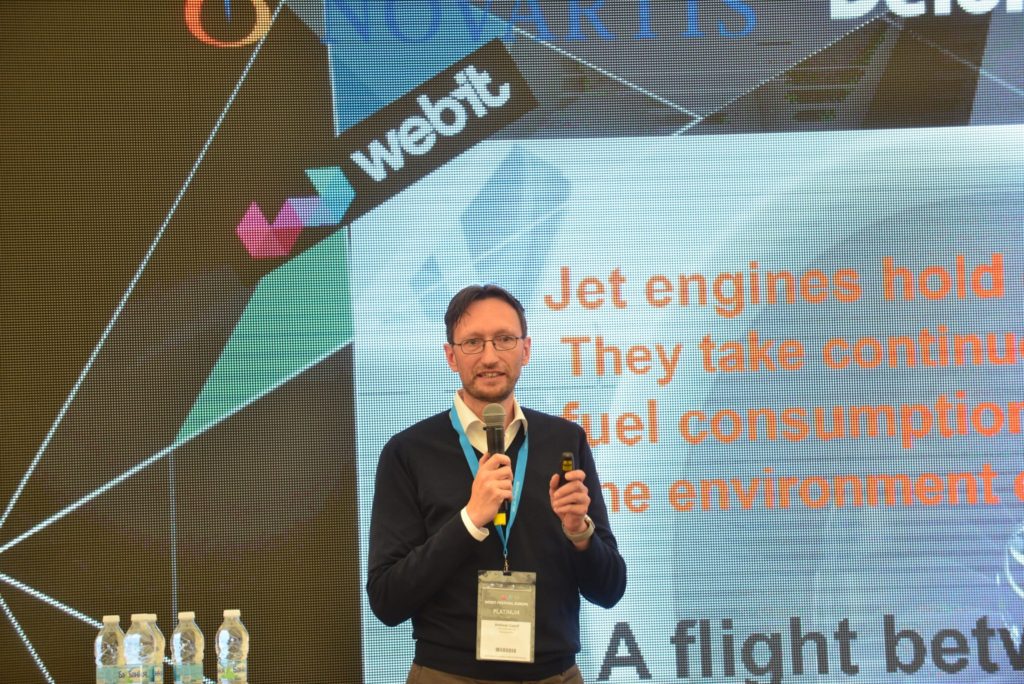 The Founder & CEO of Biovotion Dr. Andreas Caduff[/caption]
Today’s real game changer - GDPR is a regulation which protects the privacy of people’s data within the European Union. Patients have more control over their personal data and the right to ask their data to be deleted or exported so they can bring it to another vendor. Of course, the main focus is on privacy and the prevention of data leaks in case of which serious penalties exist.
Biovotion created Everion - a device which measures many parameters among which heart rate, number of steps, pulse wave analysis and many more. A well-known fact is that the longer we walk, the longer we will live. What makes Everion special is that it is a device that can be worn not only during our workout, but also prior and after it, pretty much 24 hours in a day.
After Biovotion developed the device which gathers and stores a lot of data, they launched an app. The company didn’t stop there - in fact, the next step towards secure data storage and the ability to export functionalities was the cloud. Finally, in order to create a functioning ecosystem out of this medical device, Biovotion needed a communication platform. The truth is, only when all necessary elements are present, it is possible to develop a sustainable business that creates value.
Medical wearables gather a lot of data - the health and fitness data together with the true medical data can be combined to get the most accurate results of what is happening inside our bodies.
The Founder & CEO of Biovotion Dr. Andreas Caduff[/caption]
Today’s real game changer - GDPR is a regulation which protects the privacy of people’s data within the European Union. Patients have more control over their personal data and the right to ask their data to be deleted or exported so they can bring it to another vendor. Of course, the main focus is on privacy and the prevention of data leaks in case of which serious penalties exist.
Biovotion created Everion - a device which measures many parameters among which heart rate, number of steps, pulse wave analysis and many more. A well-known fact is that the longer we walk, the longer we will live. What makes Everion special is that it is a device that can be worn not only during our workout, but also prior and after it, pretty much 24 hours in a day.
After Biovotion developed the device which gathers and stores a lot of data, they launched an app. The company didn’t stop there - in fact, the next step towards secure data storage and the ability to export functionalities was the cloud. Finally, in order to create a functioning ecosystem out of this medical device, Biovotion needed a communication platform. The truth is, only when all necessary elements are present, it is possible to develop a sustainable business that creates value.
Medical wearables gather a lot of data - the health and fitness data together with the true medical data can be combined to get the most accurate results of what is happening inside our bodies.
 The Founder & CEO of Biovotion Dr. Andreas Caduff[/caption]
Today’s real game changer - GDPR is a regulation which protects the privacy of people’s data within the European Union. Patients have more control over their personal data and the right to ask their data to be deleted or exported so they can bring it to another vendor. Of course, the main focus is on privacy and the prevention of data leaks in case of which serious penalties exist.
Biovotion created Everion - a device which measures many parameters among which heart rate, number of steps, pulse wave analysis and many more. A well-known fact is that the longer we walk, the longer we will live. What makes Everion special is that it is a device that can be worn not only during our workout, but also prior and after it, pretty much 24 hours in a day.
After Biovotion developed the device which gathers and stores a lot of data, they launched an app. The company didn’t stop there - in fact, the next step towards secure data storage and the ability to export functionalities was the cloud. Finally, in order to create a functioning ecosystem out of this medical device, Biovotion needed a communication platform. The truth is, only when all necessary elements are present, it is possible to develop a sustainable business that creates value.
Medical wearables gather a lot of data - the health and fitness data together with the true medical data can be combined to get the most accurate results of what is happening inside our bodies.
The Founder & CEO of Biovotion Dr. Andreas Caduff[/caption]
Today’s real game changer - GDPR is a regulation which protects the privacy of people’s data within the European Union. Patients have more control over their personal data and the right to ask their data to be deleted or exported so they can bring it to another vendor. Of course, the main focus is on privacy and the prevention of data leaks in case of which serious penalties exist.
Biovotion created Everion - a device which measures many parameters among which heart rate, number of steps, pulse wave analysis and many more. A well-known fact is that the longer we walk, the longer we will live. What makes Everion special is that it is a device that can be worn not only during our workout, but also prior and after it, pretty much 24 hours in a day.
After Biovotion developed the device which gathers and stores a lot of data, they launched an app. The company didn’t stop there - in fact, the next step towards secure data storage and the ability to export functionalities was the cloud. Finally, in order to create a functioning ecosystem out of this medical device, Biovotion needed a communication platform. The truth is, only when all necessary elements are present, it is possible to develop a sustainable business that creates value.
Medical wearables gather a lot of data - the health and fitness data together with the true medical data can be combined to get the most accurate results of what is happening inside our bodies.
“The biggest value that we derived today is data gathered individually.”, Caduff said.Everion’s interface enables consumers to understand very quickly what is happening and what the gathered data actually means. The device allows consumers to monitor their physiological condition continuously which means they get the full picture of how their body functions. Making this information accessible to people encourages them to take care of themselves and manage their health situation. The new era of physiological monitoring introduces hand attachments capable of monitoring the heart rate variability. These medical devices tolerate motion and are very easy to use. The goal is to benefit people by making accurate measures and communicate them with a user-friendly interface. You can watch his full lecture here: If you want to keep up with the latest trends in the world of digital economy and technology, then Webit.Festival is the right place for you. Visit our website and book 2 in 1 of our Super Earlybird tickets for Webit.Festival Europe 2018. Feel the Webit vibe with some of the best photos from this year’s event! [easingslider id="4954"]
IBM is about to make ultimate data protection a reality
IBM introduces its IBM Z mainframe which is able to encrypt huge amounts of data at all times and at every level of a network.
Mainframes refer to large computers which support thousands of applications and users simultaneously. Although networks of smaller computers and cloud computing have taken the lead in recent decades, the processing power and reliability of mainframes prolong their existence. IBM’s continuous efforts to update its mainframes secure the company’s position as a market leader.
As the world goes digital, the cyber security issue becomes one of the main concerns governments, companies and users face. According to IBM, since 2013 approximately nine billion digital data records have been corrupted by hackers. Only four percent of that data was encrypted, making it easy for cyber criminals to access personal information such as credit card numbers, usernames, passwords and social security numbers. Even encrypted data can be compromised since not all companies consider hacker-proof cryptography. In fact, the encrypted data is the valuable information worth decrypting and hackers know that.
What we need is a system able to encrypt all data at all times, making it difficult for hackers to identify the most valuable information. This is where IBM Z comes in with its great processing power which handles 12 billion encrypted transactions a day. As the Vice President of threat intelligence at IBM Security, Caleb Barlow said:
“So for any type of transaction system we can now get the safety that we’re all after, which just hasn’t really been attainable up to this point.”The ability of IBM Z to keep data encrypted all of the time unless when it is being processed, is what makes the system different. In addition, the system restricts the number of administrators who can access raw data, which means hackers will have a shorter list of targets to go after. Users get access only to the data they need without the unnecessary exposure of large amounts of data that is there but they don’t need in that moment. The company looks at the large-scale cryptographic processing as a “natural extension of the architecture”. Nevertheless, the notion that there is no such thing as perfect security, still exists. That is way, IBM developers have added a feature in which the decryption keys of the mainframe are stored. In case of a breach, the system can automatically make these keys invalid until the situation is taken back under control. As far as the adoption of IBM Z is concerned, organizations which use mainframes will be very excited about the innovation. Not to mention the economic benefits such data protection system can bring by enabling companies to comply with international data retention regulations. It is hard to predict how organizations that don’t use mainframes will react to IBM Z. The question is whether they will find the system as a relevant option for their business. Whatever the answer, it is important to understand that as Joe Clabby, an analyst at the technology assessment firm Clabby Analytics, said:
“But encrypting all data, that’s a huge step. It’s pretty exciting given what a mess the world is without it.”If you are interested in the latest trends in Cyber Security, then Webit.Festival Europe is the right place for you. During the Security & Privacy Summit, you can listen to top level speakers such as the following who have attended Webit before: the Head of Unit - Data Security & Standardisation in the European Union Agency for Network and Information Security (ENISA) Dr. Andreas Mitrakas, the Co-Founder of Distil Networks Rami Essaid and the CEO of LSEC Ulrich Seldeslachts. Here you can get more information about Webit.Festival, while here you can get all the information you need about the tickets for the event.
We can turn societal challenges into opportunities.
The situation we find ourselves in today is very unique. There are many crises in the areas of ageing, security, health, economy, migration, food and they are all happening simultaneously. In order to solve a problem, we need to look at the bigger picture and consider how each crisis contributes to the problem in question.
At the 2017 edition of Webit.Festival Europe the Adviser at DG Connect at the EU Commission Ilias Iakovidis talked about how these crises should be viewed as opportunities for innovation and entrepreneurship. It is important to understand the NGOs and social entrepreneurs can’t cope with societal challenges on their own. This is how business opportunities arise and it is up to entrepreneurs to look for them and take advantage of them.
Demographic change has the greatest impact mostly because it happens so slowly that politicians don’t notice it. It is estimated that from 25% of the world population, Europeans will shift to representing only 4%. This is a major problem that will take its toll on people’s minds and way of living.
[caption id="attachment_5165" align="aligncenter" width="640"]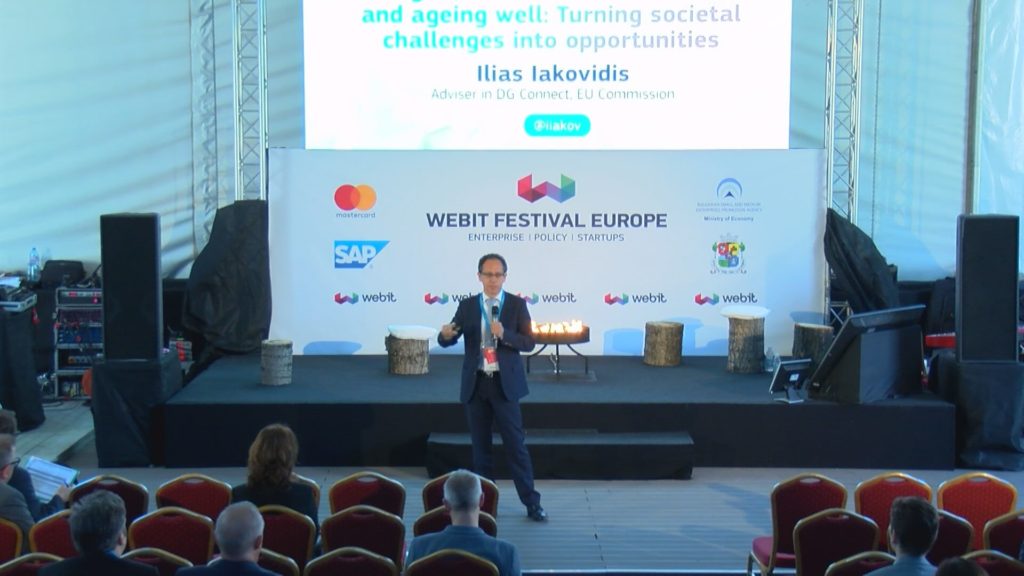 The Adviser at DG Connect at the EU Commission Ilias Iakovidis[/caption]
It is important to understand that the time of crisis is the right time to innovate. Even if we are not good at something, we should accept the challenge as an opportunity to grow. Especially when we have the infrastructure and the brains needed, the only road leads to success.
But to get to success, it is vital to know what we are doing and how exactly to do it. At some point, it is necessary to work with public administrations and the key is to understand they are not there to take care only of our issues. In fact, they have their own targets to achieve and problems to solve. If we are clever enough, we should divide the problem in parts and consult a different administration responsible for that particular issue.
The Adviser at DG Connect at the EU Commission Ilias Iakovidis[/caption]
It is important to understand that the time of crisis is the right time to innovate. Even if we are not good at something, we should accept the challenge as an opportunity to grow. Especially when we have the infrastructure and the brains needed, the only road leads to success.
But to get to success, it is vital to know what we are doing and how exactly to do it. At some point, it is necessary to work with public administrations and the key is to understand they are not there to take care only of our issues. In fact, they have their own targets to achieve and problems to solve. If we are clever enough, we should divide the problem in parts and consult a different administration responsible for that particular issue.
 The Adviser at DG Connect at the EU Commission Ilias Iakovidis[/caption]
It is important to understand that the time of crisis is the right time to innovate. Even if we are not good at something, we should accept the challenge as an opportunity to grow. Especially when we have the infrastructure and the brains needed, the only road leads to success.
But to get to success, it is vital to know what we are doing and how exactly to do it. At some point, it is necessary to work with public administrations and the key is to understand they are not there to take care only of our issues. In fact, they have their own targets to achieve and problems to solve. If we are clever enough, we should divide the problem in parts and consult a different administration responsible for that particular issue.
The Adviser at DG Connect at the EU Commission Ilias Iakovidis[/caption]
It is important to understand that the time of crisis is the right time to innovate. Even if we are not good at something, we should accept the challenge as an opportunity to grow. Especially when we have the infrastructure and the brains needed, the only road leads to success.
But to get to success, it is vital to know what we are doing and how exactly to do it. At some point, it is necessary to work with public administrations and the key is to understand they are not there to take care only of our issues. In fact, they have their own targets to achieve and problems to solve. If we are clever enough, we should divide the problem in parts and consult a different administration responsible for that particular issue.
“Innovation is not invention!”, Ilias Iakovidis said.According to him to innovate and obtain both societal and economic benefits, funding is not enough. Many people make the mistake to obsess over funding. And if the ideal for success is becoming an unicorn, then the lack of a single European market will leave many disappointed. But that doesn’t mean other opportunities don’t exist. On the contrary, they do, especially in the work with societal issues. It is all about ecosystem and in both demographic change and health we have a developed ecosystem. There are already regions putting money in this areas and entrepreneurs who work in health, smart homes, ageing and independent living should check what financial support they can receive from these regions and grab the opportunities for digital innovation. The so called silver economy creates huge opportunities for businesses. Age is a very active lead market which the EU Commission has an interest in approaching. A lot of consensus and collaboration are needed to build a successful innovation business. The creation of an ecosystem requires people to get out of their comfort zone and to even start doing things they are not very good at. But this is the only way to success. The worst thing that we witness today is scientists who are behind the invention trying to be inventors, innovators and businessmen all at the same time. The truth is, it doesn’t work that way, they have to choose to be either an inventor or a businessmen. For sure they can’t do both. You can watch his full lecture here: If you want to keep up with the latest trends in the world of digital economy and technology, then Webit.Festival is the right place for you. Visit our website and book 2 in 1 of our Super Earlybird tickets for Webit.Festival Europe 2018. Feel the Webit vibe with some of the best photos from this year’s event! [easingslider id="4954"]
Microsoft’s newly launched App enables visually impaired people to have an...
Microsoft has created Seeing AI - an intelligent app which thanks to the power of the cloud and AI working together is able to narrate the surrounding world to visually impaired people.
The scale of the impact Artificial Intelligence will have on the global labor force in the case of its mass implementation is the main topic when this technology is discussed. Nevertheless, the role AI plays in improving the quality of life of individuals is quite important and has a very positive impact on society.
Advanced AI technology used in automated vehicles can be adapted to applications which aim to help visually impaired people to navigate much better in their environment. Thanks to its ability to accurately sense the surroundings and to make quick decisions, AI can improve the life of people with vision loss by enabling them to participate more actively in the society.
Imagine the scale of the impact this technology could have considering that according to the World Health Organisation, there are 285 million people in the world who are visually impaired. 39 million of them are blind and the rest 246 million have vision loss.
Microsoft’s intelligent camera app is very easy to use - you just need to point the phone’s camera at the object or the person you want to see and then you hear information about them. By recognizing friends, their facial expressions and emotions, Seeing AI enables visually impaired people to receive information about the body language of the people in front of them, which results in a more efficient communication.
The app can be also used to read documents and to identify products by scanning the barcode. Furthermore, it can describe the environment which is surrounding the user to help them navigate better in the space. Identifying currency in the case of cash payment is a feature that Microsoft is still working on. The company defines the mission of the app as:
“Turning the visual world into an audible experience.”In order to recognize the world around it, the app uses neural networks which learn how to execute a task based on an existing example. This same technology powers self-driving cars and drones. Since the basic functions of Seeing AI are carried on the device, they can be accessed more quickly and even when the Internet connection is not very good. Only experimental features such as describing the surroundings require a connection to the cloud. The app directs the user to move the camera to the left or to the right to get the person or the object in shot. According to the tech lead on Seeing AI Saqib Shaikh, Seeing AI stands out because of the neural networks’ speed. Microsoft wanted the face recognition on a device to happen as fast as possible and they succeeded. Within milliseconds, the result is ready and the user can hear it.
“It’s all about the speed and we try to do as much as we can on the device.”, Shaikh said.Currently the app is available in US, Canada, India, Hong Kong, New Zealand and Singapore only for iOS devices. If you are interested in the latest trends in Artificial Intelligence, then Webit.Festival Europe is the right place for you. During the AI Summit, you can listen to top level speakers such as the following who have attended Webit before: the President and Global Brand Director at Havas Worldwide Jason Jercinovic, the Partner at IBM Ventures Christoph Auer-Welsbach and the CEO at CUBED Attribution Russell McAthy. Here you can get more information about Webit.Festival, while here you can get all the information you need about the tickets for the event.
The importance of Story in Storytelling and in Branded Content
The truth is everybody loves a good story. From cave paintings, through hieroglyphics all the way up to movies, stories are the tool we as human beings use to communicate and pass on information.
It is proven that the chemical makeup of the brain changes when someone tells us a story. As a result, people can align their views with these of the storyteller. This is a very powerful tool to use as a brand marketer.
At the 2017 edition of Webit.Festival Europe the Creative Director for T Brand Studio International of The New York Times Graham McDonnell shared what an important role story plays in branded entertainment. What matters is to create content people can actually engage with. Something that takes them on a journey which tells a real, human story they can relate to.
Stories follow a simple formula. First, we introduce an element which is the main thing the audience can relate to. Of course, this element should face an obstacle most often represented by the villain in the story or an internal dilemma. And the grand finale reveals the outcome, the result at the end of the story which very often is quite unexpected.
[caption id="attachment_5149" align="aligncenter" width="640"]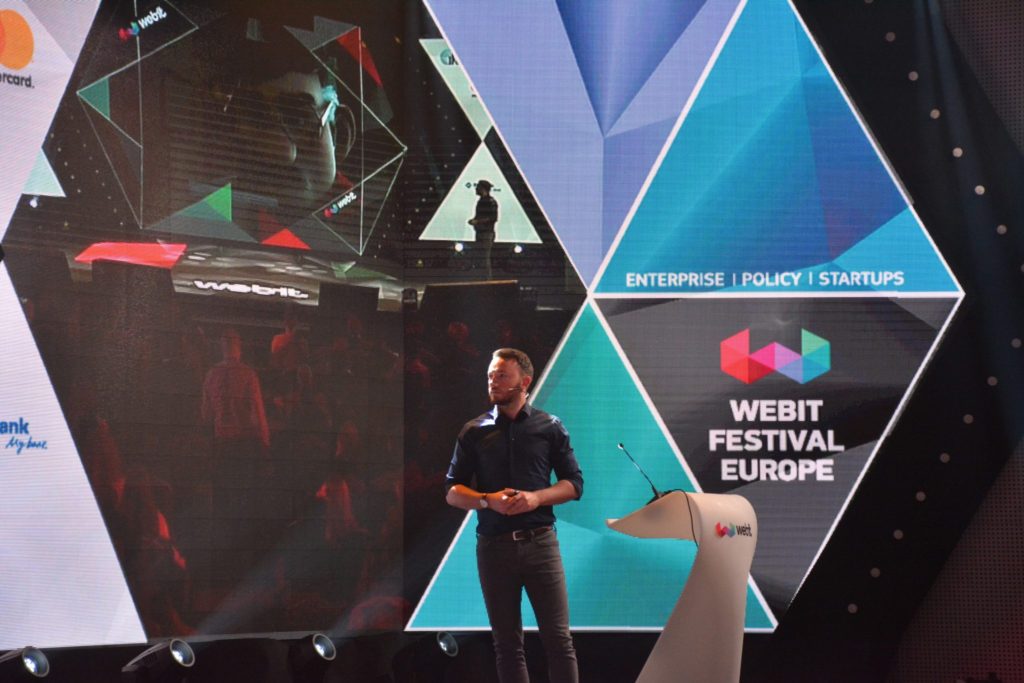 The Creative Director for T Brand Studio International of The New York Times Graham McDonnell[/caption]
When applied to brands, it is important to consider the landscape or how readers will access the content. Nowadays, the answer is on their mobile phones which according to research, people check around 10 times a day. In reality, the screen is populated with so much different content, that it is a real competition to win over the user’s attention.
The Creative Director for T Brand Studio International of The New York Times Graham McDonnell[/caption]
When applied to brands, it is important to consider the landscape or how readers will access the content. Nowadays, the answer is on their mobile phones which according to research, people check around 10 times a day. In reality, the screen is populated with so much different content, that it is a real competition to win over the user’s attention.
 The Creative Director for T Brand Studio International of The New York Times Graham McDonnell[/caption]
When applied to brands, it is important to consider the landscape or how readers will access the content. Nowadays, the answer is on their mobile phones which according to research, people check around 10 times a day. In reality, the screen is populated with so much different content, that it is a real competition to win over the user’s attention.
The Creative Director for T Brand Studio International of The New York Times Graham McDonnell[/caption]
When applied to brands, it is important to consider the landscape or how readers will access the content. Nowadays, the answer is on their mobile phones which according to research, people check around 10 times a day. In reality, the screen is populated with so much different content, that it is a real competition to win over the user’s attention.
“We need to stop interrupting what people are interested in and be what people are interested in.”, Graham McDonnell said.This is what branded content is all about. Its goal is to make the product much more easier to digest because the focus is not on the product itself but on the story it is part of. When creating a brand story a small change in the formula mentioned earlier appears. First, we introduce the obstacle and then we present the element which is there to solve the problem. Only then, it comes time for the final outcome. Stories are told all of the time and an example Graham McDonnell gave was politics, more precisely USA elections. He stressed the important role story played in Donald Trump’s election campaign. It was a very simple and effective story but most importantly it targeted the same audience every single time.
“You got to figure out the story first and then figure out how you tell it.”, McDonnell said.He emphasized on the importance of how the story is told. It is the combination between both a really good story and the way it is told that makes the entire experience. The truth is, readers can gauge very well whether something is worth their time. Content should be divided in smaller chunks and mixed with images which according to research, people process 60 thousand times faster than words. The content should be simple and relevant to the consumer. Because what matters is to engage the consumer and create relationship based on loyalty with them, which is far more important than selling the sole product. You can watch his full lecture here: If you want to keep up with the latest trends in the world of digital economy and technology, then Webit.Festival is the right place for you. Visit our website and book 2 in 1 of our Super Earlybird tickets for Webit.Festival Europe 2018. Feel the Webit vibe with some of the best photos from this year’s event! [easingslider id="4954"]

